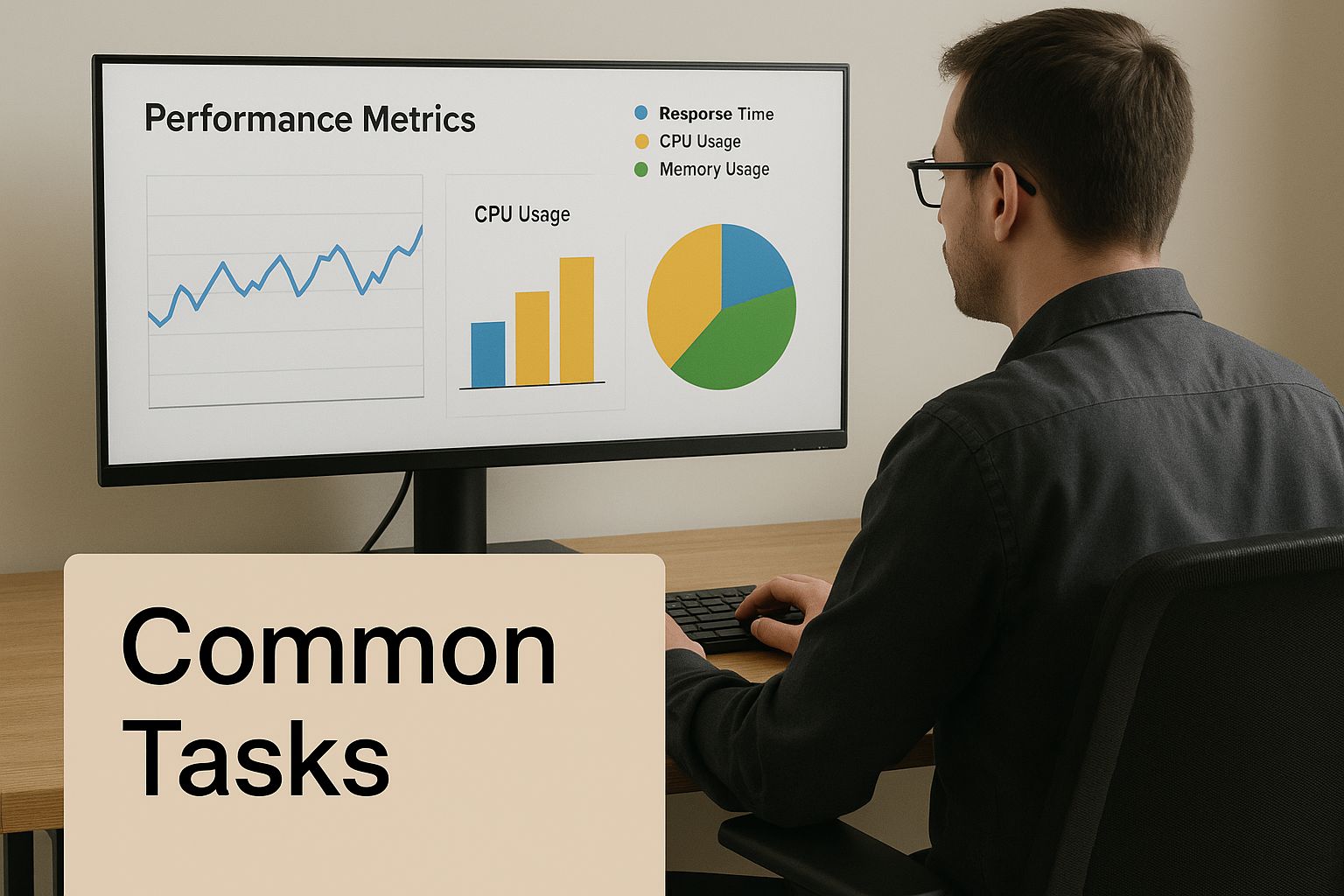It's easy to think of a website as a finished product, like a sculpture you place in a gallery and admire. But that's not quite right. A better way to see it is as a living, breathing garden—it needs constant attention to thrive and grow. Website maintenance and support is that essential, ongoing care. It’s what protects your digital investment and makes sure it stays healthy, secure, and effective long after the initial launch.
Why Your Website Needs Constant Care

One of the most common mistakes people make is treating their new website as a "one-and-done" project. They assume that once it’s live, the work is over. The reality is that a website is a dynamic business tool that needs regular tune-ups, much like your car. If you neglect it, it won't take long for it to become outdated, sluggish, and dangerously vulnerable.
Just think about how quickly the online world moves. New security threats pop up every day, software platforms release critical updates to patch bugs, and search engine algorithms are always changing their rules. Leaving your site unmaintained is a bit like leaving the front door of your shop unlocked on a busy high street—you're just inviting trouble.
Protecting Your Digital Asset
Proper website maintenance and support isn't just about calling someone to fix things when they break. It’s about being proactive and stopping those problems from ever happening. This approach keeps your website running like a well-oiled machine, ensuring every visitor has a great experience.
A well-tended website brings tangible benefits to your business by:
- Strengthening Security: Regular updates are crucial for patching security holes that hackers love to exploit. In fact, most website breaches are a direct result of outdated software.
- Boosting Performance: A fast, responsive website keeps people on your page and can even improve your rankings on search engines like Google. A slow site, on the other hand, just frustrates users and can hurt your bottom line.
- Enhancing User Experience: First impressions are 94% design-related, and that absolutely includes how well the site works. A website riddled with broken links or errors quickly erodes trust and can tarnish your business's reputation.
Ultimately, consistent website maintenance is an investment in reliability and peace of mind. It ensures your most important digital asset is always working for you, safeguarding your online presence and supporting your business goals around the clock.
By dedicating time and resources to upkeep, you shift from a reactive, "break-fix" mindset to a strategic, proactive one. This not only protects your initial investment but also guarantees your site continues to deliver real value for years to come.
The Four Pillars of Website Health
When you hear the term website maintenance and support, it can all sound a bit vague. What are we actually doing? To get a real sense of it, it helps to think of website health as resting on four essential pillars. Each one is a core activity that keeps your site strong, secure, and working for your business.
Picture these pillars like the legs of a table. If one gets wobbly or breaks, the whole structure is at risk. Each pillar supports a different, critical aspect of your website’s well-being, and they all work together to keep things running perfectly.
Pillar 1: Security Monitoring
Let's start with security, because frankly, nothing else matters if your site isn't safe. Think of security monitoring as the 24/7 CCTV and alarm system for your digital storefront. It's constantly on watch, scanning for any suspicious behaviour, attempted break-ins, or weak spots that hackers might try to exploit.
A sobering thought: 43% of all cyber attacks are aimed squarely at small businesses. Why? Because they're often seen as softer targets with less protection. Proactive monitoring is your best, and first, line of defence.
Good security isn't about waiting for an attack to happen; it's about stopping it before it starts. A solid security strategy includes:
- Regular Malware Scans: We actively hunt for any malicious code that might have been snuck onto your site without you knowing.
- Firewall Management: This is like putting a bouncer on the door, creating a tough barrier that blocks shady traffic from ever reaching your website.
- Vulnerability Patching: As soon as a security loophole is found in your site’s software, we're on it—closing the door on would-be attackers.
Without someone constantly watching, your website could be compromised for weeks or even months. That’s a massive risk to your data, your reputation, and your customers' trust.
Pillar 2: Software and Plugin Updates
Your website isn't a single entity. It’s built from layers of different software: its core system (like WordPress), its theme (the design), and a whole host of plugins that add specific features. Each of these is like an app on your phone—developers are always releasing updates to fix bugs, roll out new features, and, crucially, patch security holes.
Ignoring these updates is one of the single biggest reasons websites get hacked. An out-of-date plugin is like leaving a window wide open with a sign that says, "Come on in!" A proper website maintenance and support plan ensures every piece of software is updated in a safe, controlled manner. This prevents those updates from accidentally breaking something on your site while locking down its security.
Pillar 3: Regular Backups
Let's be realistic: sometimes, despite every precaution, things just go wrong. A server might crash, a software update could clash with another one, or a simple human error might delete a critical page. This is exactly why regular backups are your website’s non-negotiable insurance policy.
A backup is simply a full copy of your website's files and its database, tucked away safely in a completely separate location. If the worst should happen, we can quickly restore this copy and get your site back online with minimal fuss and downtime. Depending on how often you update your content, these backups might run daily or weekly, but for any serious business, they are absolutely essential.
Pillar 4: Performance Optimisation
Finally, we have performance optimisation, which really boils down to one thing: speed. In today’s world, a slow website is a business killer. Your visitors have zero patience, and search engines like Google actively reward sites that load in a flash.
Optimising performance involves a whole toolbox of techniques designed to make your site as snappy as possible. This isn't a one-and-done job; it's an ongoing process that includes:
- Image Compression: Shrinking image file sizes so they load quickly without looking pixelated.
- Code Minification: Tidying up the website’s code, stripping out unnecessary characters to make it leaner and faster.
- Caching: Storing temporary copies of your pages so they can be served up to visitors almost instantly.
- Database Optimisation: Giving your website's database a regular clean-up so it can find and deliver information more efficiently.
A faster website creates a better experience for your users, which directly translates into more engagement, higher conversion rates, and better rankings in search results. If you’re curious about where you stand, you can learn more about the best website performance monitoring tools and see how your site measures up.
How Your Website Type Shapes Your Maintenance Plan
When it comes to website maintenance and support, there's no such thing as one-size-fits-all. The kind of care your site needs really depends on what it does. A simple online brochure, for example, has far fewer moving parts than a busy online shop that's processing orders around the clock.
I often tell clients to think of it like owning a car. A standard family runaround just needs its regular MOT, oil changes, and tyre checks to keep it safe on the road. A high-performance racing car, on the other hand? That demands a dedicated team of mechanics, constant fine-tuning, and a much more intensive level of care to perform at its best. Your website is exactly the same.
Figuring out which category your site falls into is the first, most important step. It helps you set a realistic budget, understand the work involved, and find the right support plan to keep everything running smoothly.
Comparing Common UK Business Websites
Let's look at the three main types of websites UK businesses typically have and what their day-to-day maintenance actually involves.
-
Brochure Websites: Think of these as your digital business card. Their job is simple: tell people who you are, what you offer, and how to get in touch. Since the content doesn't change much, maintenance is straightforward, focusing on the essentials like core security, backups, and software updates.
-
Content-Heavy Blogs or News Sites: These sites are much more alive. With new articles, posts, and images going up all the time, they need more hands-on attention. The focus here is on keeping things fast as the site grows, checking for broken links, and making sure every new piece of content is properly optimised.
-
eCommerce Stores: An online shop is the most demanding of the lot. It’s handling sensitive customer information, taking payments, and juggling stock levels. Maintenance is intense and non-negotiable, requiring top-tier security, constant monitoring of the checkout system, and immediate patches to prevent any hit to your sales.
This image gives a great overview of the different tasks involved for each.

As you can see, everyone needs backups, but the complexity skyrockets from a basic brochure site to a full-blown eCommerce platform.
How Functionality Affects Cost
Naturally, this difference in complexity has a direct impact on how much you should expect to pay for upkeep. The more features and functionality your website has, the more time and expertise are needed to maintain it. This is a critical factor for any UK business trying to budget for its online presence.
To give you a clearer idea, here’s a breakdown of what you might expect to pay.
Typical UK Monthly Maintenance Costs by Website Type
| Website Type | Typical Monthly Cost Range | Key Maintenance Focus |
|---|---|---|
| Brochure/Informational Website | £30 – £150 | Core security, backups, plugin updates |
| Blog/Content-Driven Website | £100 – £400 | Performance optimisation, link checking, content support |
| Small eCommerce Store | £150 – £600 | Payment gateway security, product updates, transaction monitoring |
| Large eCommerce/Custom Platform | £600 – £3,500+ | Advanced security, performance scaling, uptime monitoring, custom feature support |
These figures show a clear trend: as a website's role in generating revenue and handling data increases, so does the investment required to protect it.
To put it in perspective, a small UK business site might have monthly maintenance costs somewhere between £25 and £375. In stark contrast, a high-traffic eCommerce website requires a much larger investment, typically from £535 to £3,570 per month, to cover its advanced security and operational needs. You can explore a detailed cost analysis on Hostinger.com.
In the end, knowing your website's type is fundamental. It sets clear expectations for the care, attention, and investment required to keep your digital asset secure, efficient, and working hard for your business.
Understanding the Value of Professional Support
It's tempting to glance at a quote for website maintenance and support and file it away under 'business expense'. But that’s a bit like calling insurance for your shop a 'cost' instead of what it really is: essential protection for a valuable asset. Your website is no different. It's your digital shopfront, your lead generator, and often, your primary source of revenue. Professional support isn't just an expense; it’s a strategic investment to keep that asset safe and profitable.
The price tag you see for professional support in the UK isn't just a number plucked from thin air. It's a direct reflection of how complex websites have become, the relentless sophistication of security threats, and the sky-high expectations your customers have for a fast, seamless experience. When you bring an expert on board, you're not just paying for someone to fix things when they break. You're paying for foresight, expertise, and frankly, peace of mind.
What Are You Really Paying For?
When you invest in a proper maintenance plan, you’re essentially hiring a dedicated crew to ensure your digital doors stay open, secure, and running smoothly. This goes far beyond just ticking off technical tasks. It's about protecting your brand's reputation and making sure you don't lose customers because of a slow-loading page or, worse, a security warning.
So, what does that investment actually get you?
- Proactive Security: Instead of scrambling after your site’s been hacked, a professional team works to prevent it from ever happening. They’re setting up firewalls, constantly scanning for malware, and patching up security holes as soon as they’re discovered.
- Expert Problem-Solving: Something will inevitably go wrong. A plugin update might clash with your theme, or a contact form could suddenly stop sending emails. Having an expert on call means the problem gets diagnosed and fixed quickly, saving you from hours of frustration and potential lost business.
- Performance and Uptime: A dedicated team keeps a close watch on your site's speed and accessibility. This is vital, not just for keeping visitors happy, but for staying in Google's good books, too.
The Rising Costs of Maintenance in the UK
There’s no getting around it—the cost of quality website maintenance has been on the rise. But this isn't arbitrary inflation. It mirrors the increasing value and complexity of the work involved. As web technologies advance and cyber threats become more severe, the skill set needed to manage a website effectively has become far more specialised.
In the UK, you’ll find that monthly maintenance packages can vary dramatically depending on what a website needs. Costs might start from under £50 for a very basic plan and climb to over £1,600 for comprehensive support on a large, complex e-commerce site. This range is shaped by traffic levels, security requirements, and how much hands-on help you need. You can get a deeper insight into how UK agency pricing has changed over on Justtemplateit.co.uk.
Viewing professional website maintenance and support as a forward-thinking investment is the key to budgeting for it effectively. It changes the question from "How much will this cost me?" to "What is the value of protecting my online revenue and reputation?" Once you grasp what you're truly paying for, you start to see the immense value a professional partner brings to the table, keeping your business secure and thriving online.
Keeping Your WordPress Site Fast and Secure
Given how many UK businesses rely on WordPress, it’s worth taking a closer look. It's a fantastic, flexible platform, but that same flexibility—with its endless universe of themes and plugins—creates its own unique challenges. Real website maintenance and support for a WordPress site isn't a one-off task; it's a continuous cycle of care.
This ongoing attention is directly linked to performance. Years ago, a fast website was a nice perk. Now? It’s absolutely essential. Search engines like Google have put speed front and centre, using metrics like Core Web Vitals and Time to First Byte (TTFB) to judge how quickly your site responds and lets visitors interact.

The New Standard for WordPress Care
Slow loading times are one of the biggest reasons people give up on a website. If your WordPress site is lagging, it can be infuriating to figure out why. Often, the culprit is an outdated plugin, a cluttered database, or images that haven't been properly optimised. If this sounds familiar, our guide on what to do if your WordPress website is loading slow is a great place to start digging.
A professional support plan tackles these problems before they even start. The focus has shifted from simply fixing things when they break to actively optimising for a brilliant user experience. This means:
- Mobile-First Performance: Making sure your site loads instantly and looks perfect on smartphones, which is where most of your audience will find you.
- Performance Tuning: Regularly optimising your site’s database, compressing images, and setting up advanced caching to make everything feel snappy.
- Security Hardening: Going beyond basic updates by adding firewalls and malware scanning to build a tough defence against digital threats.
These practices aren’t optional extras anymore. They are the baseline for any business that depends on its WordPress site to find customers and grow. A fast, secure site builds trust and keeps people on the page.
Data-Backed Performance in the UK
The drive for better performance is clear when you look at how UK businesses are handling their WordPress sites. WordPress is a global powerhouse, and the latest statistics show a definite trend towards optimisation. In fact, over 68% of new WordPress sites in the UK are now built with mobile-first performance as a priority, and server-side upgrades have boosted loading speeds by an average of 37%. These figures show that proactive maintenance directly creates a more competitive online presence. You can dive deeper into these trends by exploring the full findings from SQ Magazine.
Ultimately, consistent maintenance ensures your WordPress site isn't just surviving, but thriving. It turns your website from a potential weak spot into a high-performing asset that backs up your business goals, strengthens your reputation, and gives every visitor a great experience.
How to Choose the Right Maintenance Partner
Finding the right partner to look after your website’s health can feel a bit like searching for a needle in a haystack, but it really doesn't need to be that complicated. The aim is to find someone you can rely on, who speaks your language and understands what your business actually needs—not just a company trying to sell you a one-size-fits-all package. Think of it less like hiring a contractor and more like bringing a trusted specialist onto your team.
When you start weighing up your options, the first thing to check is their proven expertise with your specific website platform. For instance, if your business runs on WordPress, you'll want a partner who knows it inside and out. They should be deeply familiar with its entire ecosystem, from themes and plugins to common headaches like the dreaded fatal error. Knowing how to fix a WordPress fatal error efficiently is a great litmus test for their technical chops.
Key Questions to Ask a Potential Partner
To help you sort the experts from the amateurs, it's a good idea to have a few questions up your sleeve. This will give you a real sense of their process and whether they’re the right fit.
- What does your communication and reporting look like? You need a partner who sends clear, straightforward reports that show you what work they’ve completed and how your site is performing. No jargon, just facts.
- What is your process for backups and security? Find out how often they perform backups, where those copies are kept, and what security protocols are included as standard. This is non-negotiable.
- How do you handle emergencies? A proactive attitude is fantastic, but you also need assurance that they can jump into action the moment something goes wrong.
Choosing a partner is ultimately about trust and confidence. Look for transparent pricing, clear service level agreements (SLAs), and a team that feels genuinely invested in your success.
The right partner won't just be there to put out fires; they'll help you stop them from starting in the first place. That gives you the peace of mind you need to get back to what you do best: running your business.
Frequently Asked Questions About Website Maintenance
Even after realising just how important website maintenance and support are, some practical questions always pop up. We get asked these all the time, so we’ve put together some clear, straightforward answers for you.
How Often Does My Site Need Maintenance?
Honestly, it all comes down to your website's complexity and how many visitors it handles. For most business websites, a thorough check-in once a month is a great starting point. This cadence is usually enough to cover the essentials like security scans, software updates, and creating fresh backups.
But if you're running a busy eCommerce store with daily sales, the game changes. For sites like these, the stakes are much higher. We often find they need daily monitoring to make sure every part of the operation, from the payment gateway to customer data security, is running without a hitch.
Can I Do My Own Website Maintenance?
You certainly can, especially if you have a very simple website like a personal blog. The real question is whether you have the technical skills and, more importantly, the time. For any website that’s central to your business, we strongly advise getting a professional involved.
Think of it this way: professional help isn't just about fixing what’s broken. It's about preventing expensive disasters before they happen, keeping your site secure, and freeing you up to do what you do best—run your business.
What Isn’t Included in a Typical Plan?
A good maintenance plan is designed to look after the technical health of your website. It’s all about the nuts and bolts: security, backups, performance optimisations, and software updates.
Things that are generally considered separate projects include:
- Creating new pages or writing blog posts.
- A full website redesign or rebranding.
- Developing brand-new, custom features.
- Managing your SEO or digital marketing campaigns.
These are specialised services that go beyond technical upkeep and are usually quoted for separately.
Feeling clearer about what your site needs? The expert team at LINX Repair Websites is here to provide the proactive care and support your website deserves. Contact us to learn more.
